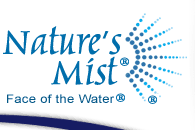







Nature's Mist®
Face of the Water™
The Art and Science of Beautiful Skin
Integumentary System
Skin is the human body's largest organ and the primary contact with the surrounding environment. The "integumentary system" (skin and associated organs) or "integument " is the most closely watched yet under appreciated organ system, covering the entire body surface. It is the only system we see on a daily basis, almost in its entirety. We devote a lot of time to improving the appearance of the integument and associated structures because others see this system as well. Skin provides clues not only to an individual's physical state but emotional as well. When something goes wrong with the skin, the effects are immediately apparent. Skin not only protects the body from the surrounding environment but can also mirror the general health of other systems as well.
Skin Layers - Epidermis, Dermis and Hypodermis
The skin consists of an outer "epidermis", the "dermis", and "hypodermis" (or "subcutaneous layer"). Although the hypodermis is usually not considered a part of the integument, it is important because of its interconnections with the dermis. The hypodermis is the deepest layer, composed primarily of fat cells. Dermal and epidermal functions are described in detail below.
Dermis
The inner "dermis", located above the hypodermis and beneath the epidermis, makes up 15-20% of our total body weight, depending upon moisture content. It gives skin its structural strength, protects the body from injury, stores water and interacts with the epidermis. It is responsible for the skin's structural integrity, elasticity and resilience and absorbs most substances that penetrate the skin. It is also where the majority of skin moisture is stored. When surface conditions dry skin, moisture is drawn from the dermis into the epidermis, then out through the stratum corneum (see epidermis below and transepidermal water loss "TEWL").
The thickest of the skin layers, the dermis comprises a tight, sturdy mesh of collagen and elastin fibers. Both collagen and elastin are critically important skin proteins: collagen is responsible for the structural support and elastin for skin resilience. The dermis also contains capillaries (tiny blood vessels) and lymph nodes (immune cell depots). The former are important for oxygenating and nourishing the skin, and the latter are essential for protecting it from invading microorganisms. Finally, the dermis contains sebaceous glands, sweat glands, hair follicles as well as a relatively small number of nerve and muscle cells.
Epidermis
The epidermis' top layer, the stratum corneum, is comprised of hard, flattened dead cells. Beneath are larger living cells and at deeper levels within the epidermis, the cells are even larger and more rounded in appearance. Within the innermost layer, new cells grow and push their way toward the surface, and in the process they flatten and lose most of their water content through pressure and dehydration. Free water will evaporate unless taken up into the dermis. In order for this to occur, water must possess certain properties like a proper pH level (more acidic than alkaline).
The epidermis' mission is to form the stratum corneum.1 Dead cells within the stratum corneum, usually remain in the exposed layer for two weeks before they are shed or washed away. The stratum corneum is an effective barrier to water loss and is mostly impermeable to external substances, including toxic materials. Although the stratum corneum is water resistant, it is not waterproof, and water from the interstitial fluids (fluid in the tissues that fills the spaces between cells) slowly penetrates the skin's surface, to evaporate into the surrounding environment. This process, accounts for a loss of roughly 500 ml (about 1pint) of water per day.
Nature's Mist, an all-natural tissue-culture grade water, insures proper absorption into the skin's deepest layer, the dermis.
1Madison, KC. (2003). Barrier function of the skin: "la raison d'etre" of the epidermis. J Invest Dermatol 121 (2): 231-41.
|






